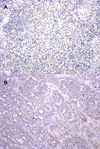BRCA1 immunohistochemistry in a molecularly characterized cohort of ovarian high-grade serous carcinomas
- PMID: 23232854
- PMCID: PMC3531916
- DOI: 10.1097/PAS.0b013e31826cabbd
BRCA1 immunohistochemistry in a molecularly characterized cohort of ovarian high-grade serous carcinomas
Abstract
BRCA1 and BRCA2 dysfunction, frequently seen in high-grade serous ovarian carcinomas, often results from germline mutations, somatic mutations, and promoter methylation. Identification of tumors with BRCA defects has therapeutic and prognostic implications. Identifying germline BRCA mutations is also important given the increased risk for hereditary breast and ovarian carcinoma. Our goal was to assess whether immunohistochemical analysis (IHC) for BRCA1 is an effective method for the detection of BRCA1 dysfunction in molecularly characterized high-grade ovarian serous carcinoma. We identified 43 high-grade ovarian serous carcinomas with known events in BRCA1 and BRCA2 included in The Cancer Genome Atlas Project. BRCA1 stain was first assessed without knowledge of the BRCA status, and a semiquantitative assessment for intensity and amount of staining was performed. The stains were reevaluated and divided into 3 categories (retained, loss, and equivocal) on the basis of correlation with genotyping data. Presence of retained BRCA staining was considered normal, whereas the other patterns, including equivocal staining or loss of staining, were considered abnormal. Two pathologists, blinded to the BRCA status, then scored 2 sets of validation cases selected on the basis of available molecular data-1 with only germline mutation status available (n=31) and 1 with comprehensive genomic data (n=39). The pathologists agreed 88% of the time in the training set and 91% in the validation sets. In the training set, abnormal BRCA staining was seen in 24 cases, of which 21 (87%) showed BRCA1 genetic abnormalities, 1 showed BRCA2 mutations, and 2 showed no BRCA abnormalities. Abnormal BRCA1 staining was noted in all 5 cases with BRCA1 germline mutations, in 3 (60%) of 5 with BRCA1 somatic mutations, and in 13 (93%) of 14 with BRCA1 promoter methylation. The 2 validation sets included 70 additional patients, and all cases with germline BRCA1 mutations (n=11) showed abnormal BRCA1 staining. Tumors with BRCA1 promoter methylation also showed abnormal staining in 6 (86%) of 7 cases. In the entire study, no cases with BRCA1 germline mutation showed intact immunostaining (negative predictive value=100%). This study shows that BRCA1 IHC is well correlated with molecular events in ovarian carcinoma. Considering the high negative predictive value for germline mutations, BRCA1 IHC appears to be an effective approach to stratify patients for germline genetic testing and to detect other mechanisms of BRCA1 dysfunction in high-grade serous ovarian carcinomas.
Conflict of interest statement
Conflict of Interest: There are no conflicts of interest to report.
Figures





Similar articles
-
BRCA1 and BRCA2 mutations correlate with TP53 abnormalities and presence of immune cell infiltrates in ovarian high-grade serous carcinoma.Mod Pathol. 2012 May;25(5):740-50. doi: 10.1038/modpathol.2011.211. Epub 2012 Jan 27. Mod Pathol. 2012. PMID: 22282309
-
Gross genomic alterations and gene expression profiles of high- grade serous carcinoma of the ovary with and without BRCA1 inactivation.BMC Cancer. 2010 Sep 15;10:493. doi: 10.1186/1471-2407-10-493. BMC Cancer. 2010. PMID: 20843305 Free PMC article.
-
BRCA mutational status, initial disease presentation, and clinical outcome in high-grade serous advanced ovarian cancer: a multicenter study.Am J Obstet Gynecol. 2017 Sep;217(3):334.e1-334.e9. doi: 10.1016/j.ajog.2017.05.036. Epub 2017 May 23. Am J Obstet Gynecol. 2017. PMID: 28549976
-
BRCA somatic mutations and epigenetic BRCA modifications in serous ovarian cancer.Ann Oncol. 2016 Aug;27(8):1449-55. doi: 10.1093/annonc/mdw142. Epub 2016 Mar 31. Ann Oncol. 2016. PMID: 27037296 Review.
-
A systematic review on the frequency of BRCA promoter methylation in breast and ovarian carcinomas of BRCA germline mutation carriers: Mutually exclusive, or not?Crit Rev Oncol Hematol. 2018 Jul;127:29-41. doi: 10.1016/j.critrevonc.2018.05.008. Epub 2018 May 14. Crit Rev Oncol Hematol. 2018. PMID: 29891109
Cited by
-
[Hereditary breast and ovarian cancer].Pathologe. 2017 May;38(3):149-155. doi: 10.1007/s00292-017-0298-5. Pathologe. 2017. PMID: 28500412 Review. German.
-
Pathology of Hereditary Breast and Ovarian Cancer.Front Oncol. 2020 Sep 29;10:531790. doi: 10.3389/fonc.2020.531790. eCollection 2020. Front Oncol. 2020. PMID: 33117676 Free PMC article.
-
The expression of DBC1/CCAR2 is associated with poor prognosis of ovarian carcinoma.J Ovarian Res. 2015 Feb 15;8:2. doi: 10.1186/s13048-015-0129-3. J Ovarian Res. 2015. PMID: 25823848 Free PMC article.
-
Baseline clinical predictors of antitumor response to the PARP inhibitor olaparib in germline BRCA1/2 mutated patients with advanced ovarian cancer.Oncotarget. 2017 Jul 18;8(29):47154-47160. doi: 10.18632/oncotarget.17005. Oncotarget. 2017. PMID: 28454085 Free PMC article.
-
BRCA1 Protein Expression in Epithelial Ovarian Cancer and Associated Clinicopathological Factors in Uganda.Obstet Gynecol Int. 2024 Oct 29;2024:9527113. doi: 10.1155/2024/9527113. eCollection 2024. Obstet Gynecol Int. 2024. PMID: 39502381 Free PMC article.
References
Publication types
MeSH terms
Substances
Grants and funding
LinkOut - more resources
Full Text Sources
Other Literature Sources
Medical
Miscellaneous

